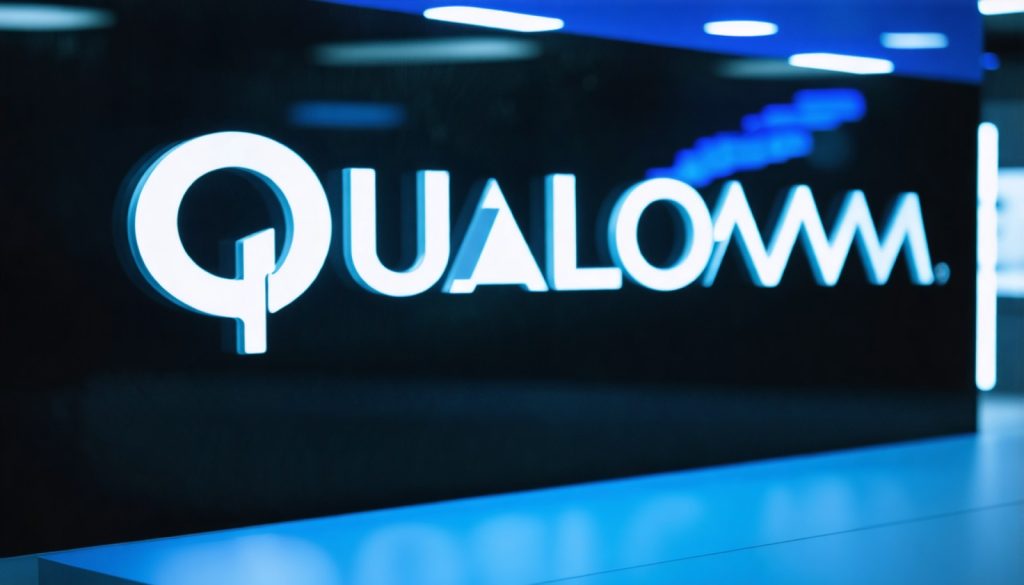
- Qualcomm adjusted its fiscal Q3 2025 revenue guidance due to uncertain international trade conditions, reflecting global trade impacts.
- Projected revenue ranges from $9.9 billion to $10.7 billion, closely aligning with Wall Street expectations but signaling potential subtle shifts in the market.
- Current tariffs announced by President Trump do not directly impact Qualcomm’s chip sales, ensuring stability amidst trade tensions.
- CEO Cristiano Amon reassures stakeholders of Qualcomm’s robust global supply network and stable customer relationships.
- Qualcomm reported a 12% increase in handset division revenue, a 59% rise in vehicle chip revenue, and a 17% growth in IoT business.
- Overall, revenue rose to $10.9 billion, surpassing initial predictions, with a 21% increase in net income to $2.8 billion, showcasing resilience and growth.
Qualcomm, a titan in the semiconductor world, recently navigated turbulent economic waters as it adjusted its fiscal forecasts in the face of uncertain international trade conditions. This adjustment, set against the backdrop of President Donald Trump’s announcement of reciprocal tariffs, saw Qualcomm revising its fiscal Q3 2025 revenue guidance—setting an eerie tone across the financial markets. What followed was a reality check for analysts who had pinned their projections just above Qualcomm’s fresh figures.
Qualcomm, the mastermind behind critical smartphone chips, predicted its revenue to shimmy between $9.9 billion and $10.7 billion for the upcoming fiscal quarter. While these numbers aren’t far off from Wall Street’s expectations, they foreshadow a subtle shift—perhaps an ominous whisper of global trade impacts yet to fully unfold.
Despite the anxiety surrounding these tariffs, Qualcomm’s chips presently dodge the direct impact, much to the relief of its executives. The company’s charismatic CEO, Cristiano Amon, confidently commented during Qualcomm’s fiscal Q2 earnings call, providing reassurance in uncertain times. The company’s global supply network remains its fortress, offering a robust defense against the unpredictable storms of global trade challenges.
Amon painted a picture of consistency within Qualcomm’s customer orders, suggesting a stable relationship with its clients and affirming that these forecasting variances don’t hint at seismic shifts but rather subtle tides of change. Even as the smartphone battleground remains competitive, Qualcomm stands as a cornerstone partner for giants like Samsung, and while contending with rivals such as MediaTek, it’s clear the market is vast enough to accommodate more than one player.
Venturing into the land of numbers, Qualcomm dazzled investors with remarkable growth beyond mere survival. Its handset division revenue ascended by 12%, reaching $6.9 billion—a testament to the thirst for premium Android devices. Turning the spotlight on another front, vehicle chip revenue soared by 59% to $959 million, while its IoT business expanded by 17%, clocking in at $1.5 billion.
Qualcomm’s overall revenue rocketed to $10.9 billion, defying initial analyst predictions of $10.6 billion. With a 17% increase in revenue and a 21% climb in net income to $2.8 billion, the company proves it’s not just weathering the storm—it’s thriving, crafting a symphony of progress that resonates across the industry.
The lesson? In an era where trade winds shift and tariffs loom like dark clouds, Qualcomm’s strategy reminds us that diversification and a solid customer base are more than survival tactics—they’re a blueprint for resilience and growth.
Qualcomm’s Resilience Amid Global Trade Uncertainties: What You Need to Know
Insights on Qualcomm’s Strategic Positioning
As Qualcomm adjusts its financial projections amidst global economic uncertainties, the company exemplifies resilience through diversification and strategic foresight. Here, we delve deeper into the context surrounding Qualcomm’s recent announcements and explore additional facets of its market position that were not fully developed in the original analysis.
How Qualcomm is Navigating Economic Challenges
1. Diversification Across Industries:
Qualcomm’s ability to maintain growth during turbulent times is largely due to its diversified portfolio. The company has strategically invested in various business segments, such as automotive and IoT (Internet of Things), to reduce reliance on any single market. This diversification mitigates risks associated with geopolitical tensions and trade disruptions.
2. Strong Partnerships:
A notable strength of Qualcomm is its robust partnerships with industry leaders like Samsung. These collaborations not only provide a stable revenue stream but also fortify the company’s market position against competitors like MediaTek. By being a key partner in the development of premium Android devices, Qualcomm ensures a consistent demand for its products.
3. Technological Innovation:
Qualcomm continues to lead in technological advancements, particularly with its 5G innovations. The ongoing rollout of 5G technology strengthens Qualcomm’s market position, as its chips are integral to the new infrastructure. This technological edge underscores Qualcomm’s commitment to staying at the forefront of the semiconductor industry.
Real-World Use Cases
– 5G Deployment: Qualcomm’s 5G technology is critical for enabling faster, more reliable mobile networks, which enhance user experiences across smartphones, tablets, and IoT devices.
– Automotive Solutions: Qualcomm’s automotive chips are key components in the development of autonomous driving and advanced infotainment systems, paving the way for smarter, more connected vehicles.
Market Forecasts and Industry Trends
5G Market Expansion:
According to a report by Grand View Research, the global 5G services market size is expected to expand at a compound annual growth rate (CAGR) of 46.2% from 2022 to 2030. Qualcomm is well-positioned to benefit from this growth due to its extensive R&D in 5G technology.
Automotive Electronics Growth:
The automotive electronics market is projected to grow significantly, driven by increasing demand for enhanced infotainment systems and safety features. Qualcomm’s advancements in this sector align with these trends, ensuring continued growth in automotive chip revenue.
Pros & Cons Overview
– Pros:
– Strong market position in 5G technology.
– Diversified revenue streams across multiple sectors.
– Strategic partnerships with key industry players.
– Cons:
– Vulnerability to global trade tensions.
– Intense competition from other semiconductor companies.
Actionable Recommendations
1. Monitor Global Trade Policies: Staying informed about global trade developments and their potential impact on tech companies like Qualcomm can provide valuable investment insights.
2. Diversify Investments: Investors should consider diversifying their portfolios to include companies like Qualcomm that demonstrate resilience through diversification and innovation.
3. Explore 5G Opportunities: Both individual and business stakeholders should explore the potential applications of 5G technology in various sectors, taking advantage of the advancements led by companies like Qualcomm.
Conclusion
Qualcomm’s ability to thrive amid global trade uncertainties serves as a testament to the power of diversification and strategic foresight. By investing in new technologies and maintaining strong industry partnerships, Qualcomm remains poised for continued success. For more information on technology trends and market insights, visit Qualcomm’s official website.



